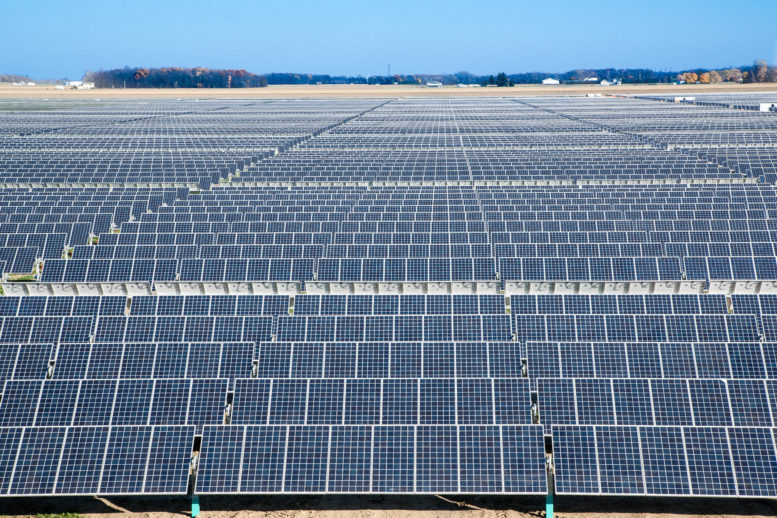By JAN LARSON McLAUGHLIN
BG Independent News
Bowling Green has long exalted its record of using renewable energy to power the community.
“We own or invested in renewable energy resources equal to 40% of our demand,” said Jim Odneal, the city’s assistant utilities director.
However, Bowling Green and other communities that have pushed for green energy have been instructed to watch the wording about their renewable energy efforts.
“This is where it gets sticky,” explained Bowling Green’s Sustainability Coordinator Amanda Gamby.
To help finance green energy projects – like solar, wind and hydro – communities often sell the Renewable Energy Credits to companies that are either required to invest in renewable energy or want to be able to say that they are “going green.”
“We don’t have a mandate, but we’ve invested in those anyway,” Odneal said.
By selling those credits to companies, communities like Bowling Green can provide green energy at more affordable rates to their residents and businesses.
“That lowers the energy costs for everyone in the city,” Odneal said.
But the cities then lose bragging rights for their green efforts. The community that invested in renewable energy and the companies that bought their Renewable Energy Credits shouldn’t both lay claim to the same green efforts.
“You can’t have two people claiming the greenness of the same source,” Gamby said.
So while Bowling Green was the first community to have a utility-scale wind farm, and has the largest solar field in Ohio, the city can’t technically claim all the Renewable Energy Credits.
“We sold that right when we sold the RECs,” Odneal said. “We would never have been able to afford this without this trading going on.”
About 40% of the energy delivered to all Bowling Green customers comes from a renewable resource (wind, solar, or hydro). As a comparison, 3% of generation in the State of Ohio came from a renewable resource in 2019 and 19% of generation in the United States came from a renewable resource in 2020.
As part of the city’s efforts to control power costs, American Municipal Power sells the RECs associated with Bowling Green’s share of the power produced by eligible renewable generation sources.
In 2021, the city and AMP sold RECs representing over 33,354 MWh of generation and received revenues of $1.4 million.
Once the RECs are sold, that energy is not considered to be “renewable” in the city’s portfolio or emissions factor. Basically, whoever purchases the REC gets to take credit for the environmental benefits.
But Odneal stressed that it was Bowling Green that invested, supported and promoted the renewable energy efforts.
Following are some green investments made by the city:
- In 2017, Bowling Green began receiving power from the largest solar field in Ohio. The 165-acre solar generating facility, constructed on city owned property, produces up to 20.0-megawatts (MW) and is connected directly to the Bowling Green Transmission System. The site consists of more than 85,000 solar panels and utilizes a single axis tracking system that allows the solar field to increase production throughout the day. In an average year, this site produces an equivalent amount of energy to power approximately 3,000 homes, avoids 25,500 metric tons of carbon dioxide emissions, and accounts for up to 3.5% of Bowling Green’s annual power supply. To add increased environmental value to the site, the city has also worked with the U.S. Fish and Wildlife Service, the Wood County Park District, and Pheasants Forever to establish a pollinator habitat on the area surrounding the solar field.
- Bowling Green is home to Ohio’s first utility-scale wind farm. The site consists of four, 391 feet tall turbines. These turbines are as tall as a 30-story building and generate up to a total of 7.2 MW of power, enough to supply electricity for approximately 2,500 homes. The project is owned by 10 municipal electric utilities with Bowling Green owning the largest share at 3.6 MW which provides up to 1.4% of Bowling Green’s annual power supply.
- Hydropower is fueled by flowing water and does not require fossil fuels, resulting in zero carbon emissions, lower fuel costs, and less pollution. Hydropower also has a higher generating capacity factor than wind or solar which means it can typically generate power during more hours of the day, addressing Bowling Green’s intermediate or base load energy needs. Bowling Green has invested in six run-of-the-river hydroelectric facilities located on the Ohio River. In a typical year, Bowling Green can expect to receive up to 35% of its energy from a hydroelectric facility.

